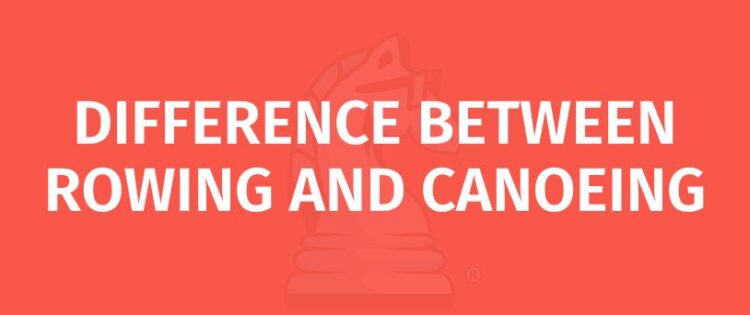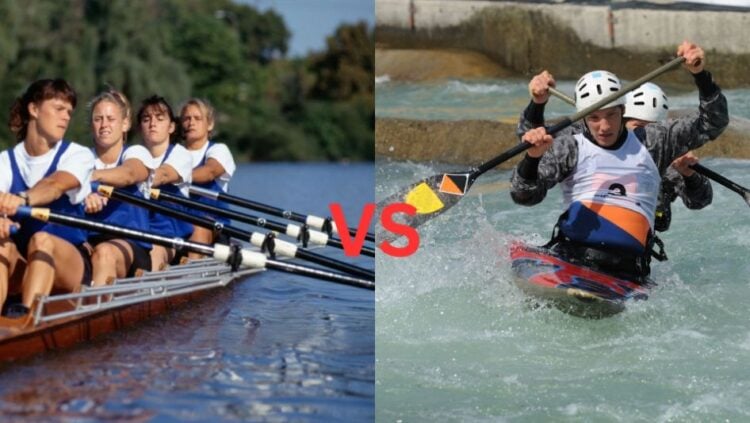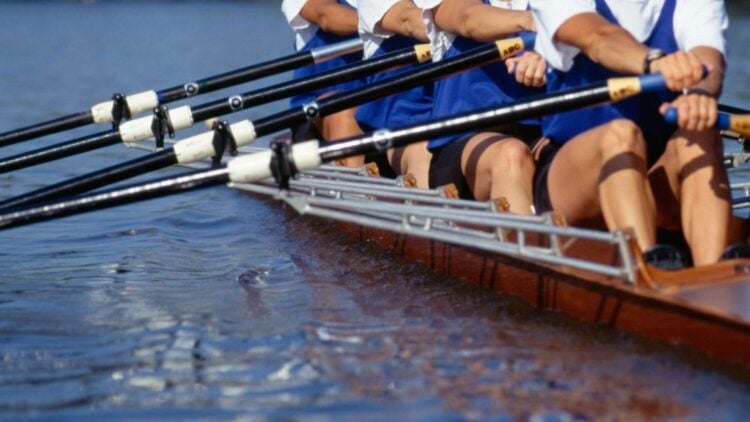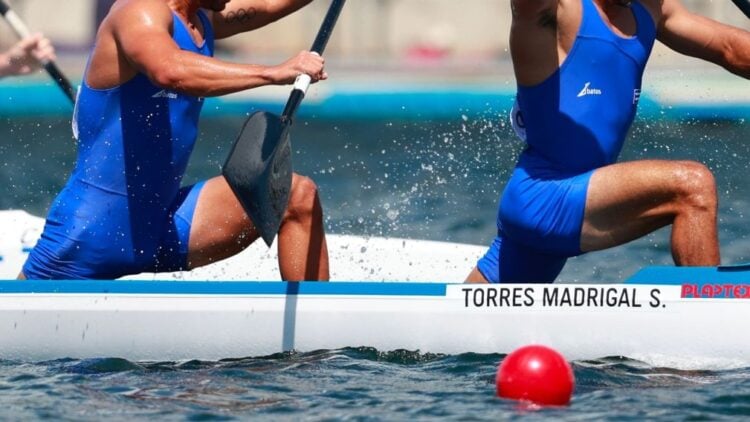
From the outside, rowing and canoeing appear as very similar sports—use an oar to maneuver your boat down a body of water. Despite this glaring similarity, though, both water sports share a few polarizing differences.
In this article, I will discuss the differences between rowing and canoeing so that you have a better understanding of these two sports.
SIMILARITIES
Before discussing what makes rowing and canoeing two independent sports, it’s important to first highlight the things that are the same or similar between them:
1) Both use oars to navigate a boat down a body of water
Single-bladed oars are used to propel and steer the boats in both sports.
2) Both sports have a flat-water “sprint” event
Although not referred to as a sprint in rowing, the two sports include at least one event in which a number of competitors quickly paddle down a straight multi-lane course toward a finish line.
DIFFERENCES

Although these two sports may seem very similar and closely knit at first glance, there are a few glaring differences that differentiate the sports from one another.
EQUIPMENT
- Boats: Racing shells (rowing) and canoes (canoeing) differ in size depending on the number of competitors in the boat. Shells tend to be much longer, measuring 27 to 62 feet in length, while canoes only range from 17 to 29 feet. Shells also have a rudder, while canoes do not.
- Oars: Both sports use single-bladed oars. However, rowing oars are generally much longer than canoeing ones, and some rowing events require the rower to use two at once.
EVENTS
ROWING

Rowing events are fairly simple, as they all are races of the same length that take place on a flat-water course that separates each team into separate lanes. Each race (regardless of team size) is generally 1,500 to 2,000 meters long (1,640 to 2,187 yards).
Each race is categorized based on team size, the type of oar being used, and whether or not a coxswain (person acting as a coach and controlling the boat’s rudder) is on board.
- Scull events use scull oars (shorter length), with each rower holding one in each hand. Team sizes range from singles, pairs, or fours.
- Coxed/Coxless events are exactly that—one has a coxswain on board, and the other doesn’t. These races include one or two rowers per boat.
- Eights are the fastest races that have eight rowers per team, each holding a single sweep oar (3 to 5 feet longer than scull oars).
CANOEING
Similar to rowing, canoeing also includes flat-water lane-based races. Generally, these races are either the singles 200m (219 yards) sprint or the singles 1000m (1,094 yards) sprint. Kayaking events are often paired alongside canoeing ones, with these including race lengths of 100, 200, 500, and 1000 meters for teams of one, two, or four.
However, the main thing that sets canoeing apart from rowing is its slalom events that take place on whitewater rapids. These involve a single competitor in a small enclosed canoe maneuvering down a fast-flowing course while trying to pass through 18 to 25 gates spread out in a manner that forces them to paddle both downstream and upstream.
Slalom events are won by the canoer with the fastest finishing time (taking into account missed gates, etc.).
GAMEPLAY
ROWING/PADDLING TECHNIQUE
The most glaring difference between rowing and canoeing can be seen in how the oars are used in each sport.
In rowing, athletes face backward (opposite the direction the boat travels) while sitting on a seat that slides along a track as they move. This entire setup allows each rower to efficiently leverage their powerful back muscles to row the oars toward them, allowing them to reach upwards of 14 miles per hour on the water.
In canoeing (flat-water races), athletes face the direction they’re moving while in a half-kneeling lunge stance (one knee up and one knee down). Then, using just a single oar, the athlete utilizes this slightly unbalanced stance to get as much leverage as possible to propel themselves through the water.
For canoe slalom events, this lunging stance would be impractical because of the roughness of the water. So instead, canoers simply sit down as if they were in a kayak.

OVERALL COMPARISON
Rowing and canoeing are two closely related water sports. After all, since the primary objective of each sport is to use an oar to maneuver a boat to the finish line in the least amount of time possible, it’s hard to imagine that there would be many stark differences between the two.
With that said, the vastly different paddling techniques used in each sport, paired with the small team sizes and whitewater aspect of canoeing, make for some interesting disparities between the two.
Rowing, which takes place on basic, flat-water courses with no changes of direction, is generally all about raw speed and power. Meanwhile, it could be argued that canoeing, with its unique paddling stance and difficult whitewater slalom courses, is more about technical skill than raw speed.
Regardless of their competitive differences, many people consider rowing and canoeing to be highly enjoyable as recreational activities. In these instances, free of all event structures and rules, it becomes quite clear that very little actually separates these two sports.
- 30 GAMES TO PLAY OVER TEXT - April 22, 2024
- 20+ FREE PRINTABLE BABY SHOWER GAMES - April 16, 2024
- 20+ College Party Games for the Best Night Ever! - April 2, 2024